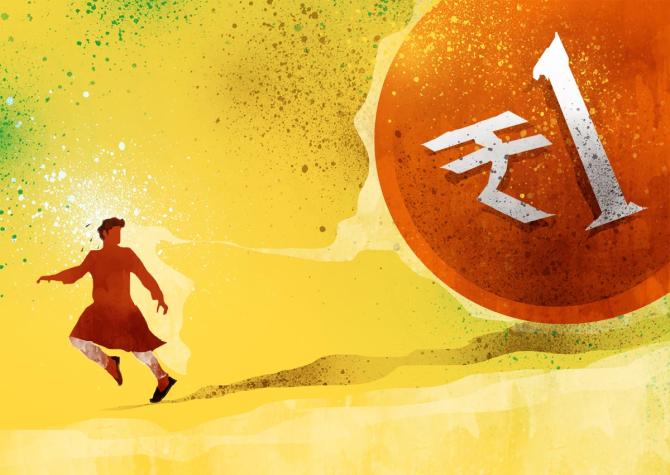Despite the demonetisation of 2016 and the rise in digital transactions that followed, the economy’s dependence on cash has remained as high as ever.

So when the Reserve Bank of India (RBI) introduced a pilot project of its version of digital cash — called the central bank digital currency (CBDC) — on December 1, many questions were asked.
Can the CBDC replace physical cash, even partially?
Can it match cash in terms of convenience?
Are CBDC transactions truly anonymous?
Given the existence of many digital mediums including the popular United Payments Interface (UPI), what was the need for introducing another digital financial transaction mode?
Let’s start with the last question.
UPI transactions, which are instantaneous, hit new records every month, breaching the Rs 10-trillion mark in just six years since its launch in 2016.
The average ticket size for UPI transactions is Rs 738 for person-to-merchant and Rs 2,576 for person-to-person exchanges, indicating that for low-value transactions people prefer UPI.
Transactions via Immediate Payment Service or IMPS, again from the stable of National Payments Corporation of India, are also instantaneous.
Like UPI, IMPS is available round-the-clock and suited for small transactions, from Re 1 to Rs 500,000.
So, to extend the argument, what was the need for UPI when IMPS was already around? After all, both forms are still in vogue.
“Earlier we had RTGS (real-time gross settlement).
"Then we came up with NEFT (National Electronic Funds Transfer) and IMPS.
"It was not a question of replacing one mode of transaction with another.
"It was always about giving the customer more choices,” said a central bank official involved with CBDC.
“All forms of money transfer can exist simultaneously.
"Customer can choose which mode she wants to use.”
Where all the other modes are operated by private players, CBDC is issued by the central bank and appears as a liability in the central bank’s balance sheet.
The RBI argues that citizens should have more confidence in a system that is operated by the central bank.
Also, there will be no merchant discount rate on digital currency, a recurrent bone of contention between banks and mobile payment services on UPI.
The entire cost of the currency is borne by the central bank.
As for cash, bankers say that its convenience is overrated. Consider ATMs: they can run out of cash and dispense only high-value notes though customers often need smaller denominations.
In cash transactions, there’s the perennial problem of soiled notes and counterfeit currency.
The CBDC obviates these problems.
Plus, a digital wallet can hold any amount of cash, unlike a physical wallet, and seamlessly transfer money.
Note, however, that money cannot be transferred to another person’s bank account.
CBDC transfers are only to other digital wallets.
What happens if you are travelling to a remote location in India where internet connectivity is uncertain?
The RBI is working on an offline mode of payment allowing some money to be stored in, say, a sub-wallet for use in offline mode.
The accounts will be reconciled when connectivity is back.
CBDC also offers the same anonymity as cash transactions because the wallet-to-wallet exchange will not be reflected in banks’ core banking system (CBS).
That only happens when a bank transfers the digital cash to a CBDC wallet, which is the same process as when someone withdraws money from the bank.
Under UPI, in contrast, every transaction is reflected and recorded in the CBS.
True, there are digital trails of transactions even between wallets.
The RBI is working on a mechanism to erase the digital trail also.
This feature will be implemented in the pilot at a later stage.
“The aim is to mimic or replicate physical cash with digital currency.
"All the characteristics of physical cash will be with digital currency, including anonymity,” the official quote above said.
From the RBI’s standpoint, digital currency has significant advantages over cash.
CBDC affects the overall value of the money — issuing function to the extent that it reduces operational costs on printing, storage, transportation and replacement of banknotes, and costs associated with delay in reconciliation and settlement.
In FY22, for instance, close to Rs 5,000 crore was incurred on security printing.
This cost, which does not include the environmental, social, and governance (ESG) cost of printing money, is predominantly borne by four stakeholders — the public, businesses, banks and the central bank.
“…establishing a CBDC issuance may come with significant fixed infrastructure costs but subsequent marginal operating costs are likely to be very low.
"Cost effectiveness of cash management using CBDC vis-à-vis physical currency provides an additional motivation for the introduction of CBDC, which may be also perceived to be environment-friendly,” the RBI’s concept note on CBDC said.
Carrying the physical currency notes to one corner of the country from the printing presses is time-consuming.
For example, it may take days to take the notes from a printing press in Dewas, Madhya Pradesh, to Nubra Valley in Leh with full security arrangements.
Transport is not an issue with digital currency. In one click, the RBI can transfer digital notes to a bank branch in Porbandar or Port Blair.
CBDCs could reduce the cost of sending remittances, particularly for a country like India which was the largest recipient of remittances ($87 billion) in 2021, according to the World Bank.
The United States is the biggest source for inward remittances to India, accounting for over 20 per cent of these funds.
The cost of remittance transactions is high.
For sending money abroad, it ranges between Rs 500 and Rs 750 for Rs 1 lakh.
For inward remittances, the cost of sending $100 is around $5 to $7.
CBDC is expected to reduce the cost of remittances drastically.
Following the launch of the pilot project, Dinesh Khara, chairman of State Bank of India, said, “The RBI’s pilot project on retail-CBDC is a game changer with durable effects that should ensure better monetary transmission at much lesser costs.”
But the game will not change overnight.
Building customer confidence for using CBDC can take years. In short, physical cash is not going to vanish anytime soon.
| The CBDC-retail pilot |
|
4 banks will participate in the initial stage, in 4 cities in closed user group comprising merchants and customers It would be issued in the same denominations as paper currency and coins (50p & Rs 1) There will be a unique serial number for every note with governor’s signature with the promise to pay the bearer the sum When RBI is giving the currency to banks, it is using distributed ledger technology API is used when a bank transfers the currency to the CBDC wallet Laws applicable to physical currency will apply to digital currency mutatis mutandis Transactions can be both person-to-person and person-to-merchant |











